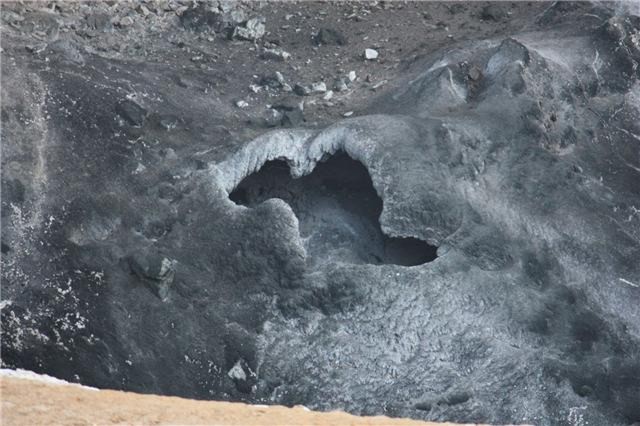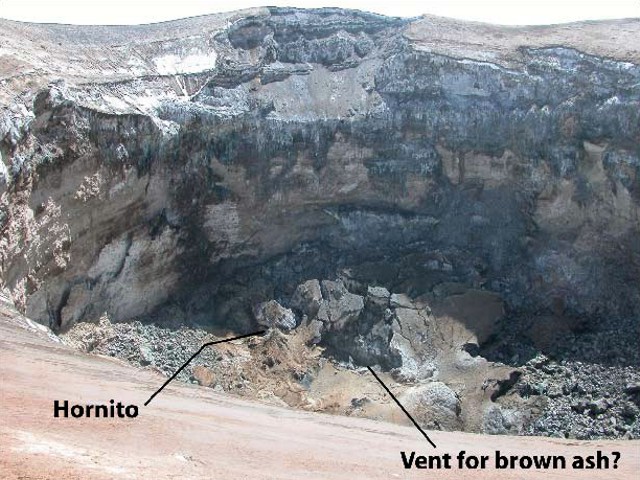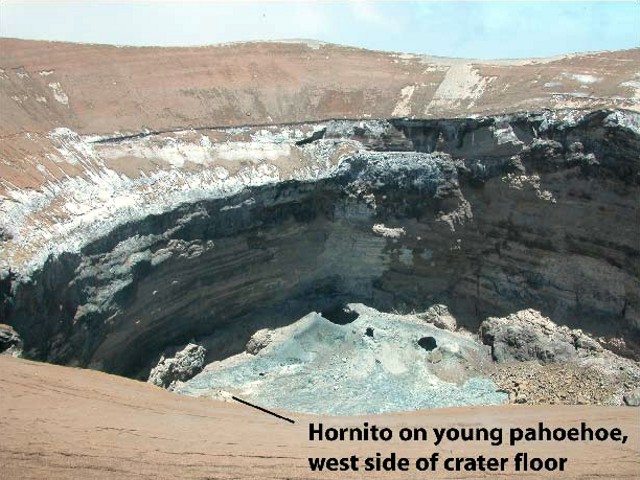Report on Ol Doinyo Lengai (Tanzania) — May 2010
Bulletin of the Global Volcanism Network, vol. 35, no. 5 (May 2010)
Managing Editor: Richard Wunderman.
Ol Doinyo Lengai (Tanzania) Eruptions and lava flows in February 2010; quiet during March 2010
Please cite this report as:
Global Volcanism Program, 2010. Report on Ol Doinyo Lengai (Tanzania) (Wunderman, R., ed.). Bulletin of the Global Volcanism Network, 35:5. Smithsonian Institution. https://doi.org/10.5479/si.GVP.BGVN201005-222120
Ol Doinyo Lengai
Tanzania
2.764°S, 35.914°E; summit elev. 2962 m
All times are local (unless otherwise noted)
Visitors who climbed Ol Doinyo Lengai (figure 138) in February 2010 observed periodic eruptions from a small fissure, steam emissions from an area of the crater rim, and fresh lava flows. Another group visited the volcano in March 2010 and saw lesser activity, but documented some features (figure 139). Table 24 gives an updated summary of brief observations from visitors through March 2010, reported primarily on Frederick Belton's website (a continuation of observations reported in BGVN 34:05 and 34:08).
 |
Figure 138. View in late August 2009 of Ol Doinyo Lengai's N crater looking N from the rim. The collapse area on the NE crater rim is apparent on the far side. Courtesy of Thomas Holden. |
Table 24. Summary of selected observations of Ol Doinyo Lengai (from a climb, aerial overflight, flank, or satellite) from October 2009 through March 2010. Courtesy of Frederick Belton.
| Date | Observer | Observation Location | Brief Observations |
| 01 Oct 2009 | Tony van Marken, Sean Disney, Matthew van Marken | Climb | "We did not see moving lava-but it was making a rumbling noise...." (T. Van arken expedition website) |
| 20 Oct 2009 | Schlak Boshoff, Willem Daffue | Climb | Through wind and rain on the crater rim they "...could hear the vents blowing below, as well as bubbling sounds, but could not see a thing!" |
| 16 Jan 2010 | Hans Schabel | Climb | "We gaped into the impressive jumble of debris at the bottom of the crater. Saw some fumaroles near the rim, but otherwise things are quiet." |
| 11 Feb 2010 | Alexander Daneel, Martin Dodwell, Frank Louw | Climb | "You could even hear the magma moving within the bowels of the mountain and there was a small fissure that erupted every time it 'growled.' There also was steam coming from an area of the rim of the crater right next to the part that collapsed. The collapsed area is almost a hundred meters wide." |
| 14-15 Feb 2010 | Frank Möckel, Kerstin Nindel, Thomas Seifert, Peter Slesaczeck | Climb | See text. |
| 12 Mar 2010 | David Sherrod, Kisana Mollel, Olemelok Nantatwa | Climb | See text. |
Belton summarized the reports and photos of climbers over the last few months by noting that it appeared that there had been a return to the small eruptions of natrocarbonatite lava and cone building that were typical prior to the 2007-2008 explosive eruption. Although the new lava had not been sampled and its composition is unknown, the crater floor vents were typical of lava pond basins and spatter cones that characterize eruptions of low-viscosity natrocarbonatite lava.
Observations during 14-15 February 2010. During the night of 14-15 February 2010, Frank Möckel, Kerstin Nindel, Thomas Seifert, and Peter Slesaczeck, German geologists, climbed via the W route to investigate the volcano and numerous small cones and craters (such as Sinja Lalarasi cone, Armykon hill, Black Belly, Dorobo cone, Nasira cones; figure 140). Möckel noted that the route was covered with gray ash and lapilli of the 2007-2008 eruptions, and the vegetation was totally destroyed.
The upper part of the volcano had many erosional gullies. The surface of the ash was strongly cemented, to a thickness of ~0.5-1 cm. Under this solid layer the ash was still loose. About 500 m below the S crater rim, the surface was also cemented, but many large bombs, stones and blocks were embedded, forming a very rough surface.
The rim of the new ash cone was only ~1 m wide, and many small bombs were lying on it. The group saw new, small black hornitos and cones (figure 141) in addition to a new black lava flow on the S part of the crater floor. The three new hornitos in the western-most part of the crater floor looked very fresh. In the middle of the crater floor was a gray hornito. The E part of the crater floor was collapsed, containing older lava that was light gray and slightly altered. The amount of new lava inside of the cone was small. In and around the crater many fumaroles were observed, emitting sulfur odors. No seismic activity was noticeable, and the group heard no noise from the crater.
 |
Figure 141. Detail of a vent on the floor of Ol Doinyo Lengai's N crater on 14 February 2010. Note the cone's rim in the left foreground. Courtesy of Frank Möckel. |
Observations during 12-13 March 2010. David Sherrod, Kisana Mollel, and Olemelok Nantatwa (2010) visited the N crater on 12 March 2010, finding it quiescent. They made a map (figure 138) and recorded measurements of crater depth, diameter of the crater rim, and dips of strata, using compass, inclinometer, laser rangefinder, and a handheld GPS receiver. According to their terminology, the 'throat' refers to the steep-sided inner crater and 'mouth' to the total opening of the crater (figure 142).
 |
Figure 142. Schematic cross section depicting the N crater on 12 March 2010. Courtesy of Sherrod and others (2010). |
The crater rim, approximately circular, ranged in diameter from 270-310 m (figure 143). They measured the crater depth to be 110-122 m, two-thirds or more of that was the height of cliffs that rise directly from the crater floor to its throat, and the remainder was the height of the sloping crater rim. If the crater had not deepened since June 2009, then previously reported depths of 80 m were underestimates. From its rim, the crater mouth sloped inward 30°, descending at that pitch for 15-30 m before ending abruptly at the cliffs of the crater throat.
 |
Figure 143. View looking NE on 12 March 2010 showing large-block rockfall on the Ol Doinyo Lengai crater floor and resulting scar on NE rim of the crater. Courtesy of Sherrod and others (2010). |
Fine-grained pale-gray or light-brownish gray ash mantled the upper slopes. A rockfall that occurred before April 2009 (A. Daneel's photos in BGVN 34:05) had scalloped the NE crater slope, leaving a shallow scar 70 m wide (figure 143). Outward-dipping beds of vent-building tephra, exposed by the scar, provide visual evidence that the mouth-coating ash layers are thin, only 30 cm or less in most places. The throat is ~200 m diameter, and the crater floor has an area of 3.26 ha (3.26 x 104 m2).
The crater as viewed on 12 March appeared unchanged from its appearance in photos taken a month earlier by Möckel; at that time, pahoehoe had covered nearly half of the crater floor. Sulfur odors were weak, and steam escaped from the few cracks that cut across the crater slopes. Neither steam nor fume were notable in the deeper part of the crater. Several volcanic and erosional events (1-3 below) could be surmised from geological relations on the crater floor, although none of the events is dated except by observations during previous visits. The recent lava flows and hornitos presumably are carbonatite, but none was sampled because they are inaccessible.1) Globs of lava were spattered on the throat walls. The spatter and rock alteration obscure much of the layering of strata exposed in the cliff faces.
2) Rubble from wall collapses formed talus cones over more than half the floor. The oldest deposits comprise large blocks from the pre-April 2009 rockfall that carved the E side of the crater (figure 144). This large-block rockfall has light brown ash on it, erupted from a 3-4-m-wide pit blasted through the talus debris. Several smaller ash-rimmed craters seen in March and April 2009 photos (S. L?bben and B. Wilhelmi, respectively, on Belton's website) were muted. A small hornito nestled in the talus with short pahoehoe flows was covered by the same brown ash. If the hornito is a product of June 2009 activity, then the brown ash must post-date June 2009.
3) Young gray pahoehoe, lacking any overlying ash, covered about 1.37 ha (1.37 x 104 m2), or 40 % of the crater floor (figure 144, left side of crater floor). It issued from three boccas near the N crater wall (also photographed during 12-14 March 2010). Within this field of pahoehoe is the second of the two hornitos on the crater floor.
The faintest of noise was heard from the area of the three boccas in the N crater. The sound was reminiscent of sloshing heard deep in pits on Kīlauea, although with more of a drumming percussion, like that of periodic gas release occurring every 3-10 seconds, but wind across the crater rim made it extremely difficult to resolve the crater sounds or their origin. When a nighttime visit to the rim was made on 13 March no incandescence was seen.
The S crater, where Sherrod, Mollel, and Nantatwa camped during 12-13 March, was dotted by over 200 ballistic craters, features presumably resulting from the eruptive events of 2007-08. The shallow impact craters, as wide as 1.5 m diameter, chiefly or entirely postdate the ashfall that accompanied the 2007-08 eruptions, judging from crater preservation and the deformation of surface beds.
Hazards. Sherrod commented that under the quiescent conditions encountered in mid-March 2010, the chief hazard at the N crater was rim stability. Rim-collapse hazard may diminish with time as the rim materials become better cemented; or the hazard may increase as ongoing alteration weakens otherwise stable rock. The NE rim seemed especially unstable.
No perceptible gas hazards were found. The summit area was well ventilated, and the smell of sulfide gas was weak. Measurements made by inserting a handheld device into low-temperature steaming cracks at the summit detected no CO2. Null values were also obtained when placing the CO2 monitor into shallow pits in the S crater where soil gas might percolate, but the holes were so shallow (< 60 cm) that breezes probably prevent gas accumulation. Concentration of ground CO2 was unlikely to pose a hazard for those in closed areas (such as tents), given the wind. The N crater's cliff-lined walls precluded access to the only obvious topographic trap for CO2.
Recent publications. Abstracts of several papers given at the Cities on Volcanoes 6th (COV6) Conference at Tenerife, 31 May-4 June 2010, described the behavior, volatiles, minerals (including gem-quality ha?yne?Zaitsev and others, 2009), and petrology at Ol Doinyo Lengai. Wiedenmann and others (2010) described melilite minerals that allow tracing the volcano's evolution of rock types. Stoppa (2010) compared Italian carbonatites with those from Ol Doinyo Lengai.
References. Keller, J., Zaitsev, A.N., and Wiedenmann, D., 2006, Primary magmas at at Oldoinyo Lengai: The role of olivine melilitites: Lithos, v.91, no. 1-4, p. 150-172; doi:10.1016/j.lithos.2006.03.014.
Sherrod, D., Mollel, K., and Nantatwa, O., 2010, Oldonyo Lengai: Trip Report, March 12-14, 2010, informal report (URL: http:/Sherrod_OldonyoLengai_March12_20106-1.pdf).
Stoppa, F., 2010, CO2 Discharge and Volcanic Risk in Italy, Cities on Volcanoes 6th (COV6) Conference, Tenerife, Canary Islands, Spain, 31 May-4 June 2010, Abstract Volume, p. 57-58 (URL: http://www.citiesonvolcanoes6.com/).
Wiedenmann, D., Keller, J., and Zaitsev. A.N., 2010, Melilite-Group Minerals at Oldoinyo Lengai, Tanzania, Cities on Volcanoes 6th (COV6) Conference, Tenerife, Canary Islands, Spain, 31 May-4 June 2010, Abstract Volume, p. 24 (URL: http://www.citiesonvolcanoes6.com/).
Zaitsev, A.N., Zaitseva, O.A., Buyko, A.K., Keller, J., Klaudius, J., and Zolotarev, A.A., 2009, Gem-Quality Yellow-Green Ha?yne from Oldoinyo Lengai Volcano, Northern Tanzania: Gems & Gemology, v. 45, no. 3, p. 200-203.
Geological Summary. The symmetrical Ol Doinyo Lengai is the only volcano known to have erupted carbonatite tephras and lavas in historical time. The prominent stratovolcano, known to the Maasai as "The Mountain of God," rises abruptly above the broad plain south of Lake Natron in the Gregory Rift Valley. The cone-building stage ended about 15,000 years ago and was followed by periodic ejection of natrocarbonatitic and nephelinite tephra during the Holocene. Historical eruptions have consisted of smaller tephra ejections and emission of numerous natrocarbonatitic lava flows on the floor of the summit crater and occasionally down the upper flanks. The depth and morphology of the northern crater have changed dramatically during the course of historical eruptions, ranging from steep crater walls about 200 m deep in the mid-20th century to shallow platforms mostly filling the crater. Long-term lava effusion in the summit crater beginning in 1983 had by the turn of the century mostly filled the northern crater; by late 1998 lava had begun overflowing the crater rim.
Information Contacts: Frederick Belton, Developmental Studies Department, PO Box 16, Middle Tennessee State University, Murfreesboro, TN 37132, USA(URL: http://www.mtsu.edu/~fbelton/ and http://oldoinyolengai.pbworks.com/); Tony van Marken, XVenture Consulting (Pty) Ltd., Po Box 581, Franschhoek, 7690, South Africa (URL: http://www.humanedgetech.com/expedition/OlDoinyoLengai2009); David Sherrod, Cascades Volcano Observatory (CVO), U.S. Geological Survey, 1300 SE Cardinal Court, Building 10, Suite 100, Vancouver, WA 98683-9589, USA (URL: https://volcanoes.usgs.gov/observatories/cvo/).




